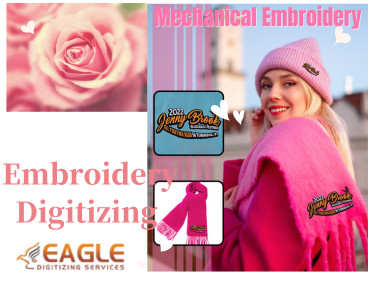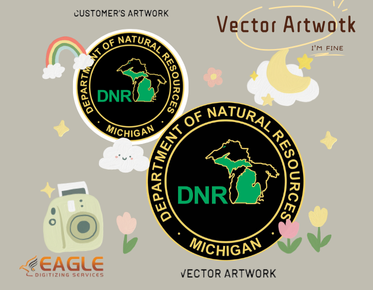Woven or Embroidered: A Side-by-Side Comparison of Patches
Patches have
transcended their utilitarian roots to become a bold statement of personal
style and creativity. From jackets adorned with nostalgic designs to bags
sporting customized logos, patches are everywhere, representing everything from
subcultures to high fashion. This article delves into the intricacies of woven
and embroidered patches, two popular choices in the world of textile
embellishments. Understanding their differences can help anyone—from hobbyists
to brands—make informed decisions that resonate with their unique aesthetic.
Understanding Woven Patches
What
Are Woven Patches? The Basics
Woven patches are
crafted by weaving threads together on a loom, creating a smooth, detailed
image that often includes intricate designs. They are characterized by their
flat, sleek finish, which makes them ideal for capturing fine details and
vibrant colors. With the ability to feature complex patterns without bulk,
woven patches offer a distinctive look that can elevate any garment or
accessory.
How
Woven Patches Are Made: A Closer Look
The creation of
woven patches involves a meticulous process that begins with a digital design.
This design is translated into a weaving pattern, which is then fed into a
loom. As the loom operates, it interlaces colored threads, producing a patch
that is both visually appealing and durable. The final product is often
finished with a merrowed edge, giving it a polished look and preventing
fraying.
Ideal
Uses for Woven Patches
Woven patches
shine in various applications, particularly where detail and precision are
paramount. They are excellent for uniforms, promotional items, and fashion
apparel. Their smooth texture allows for easy attachment to fabrics, making
them suitable for garments that require a sleek appearance without the added
bulk of embroidery.
Understanding Embroidered Patches
What
Are Embroidered Patches? The Essentials
Embroidered
patches, on the other hand, are made by stitching thread directly onto a fabric
backing. This method creates a textured, raised design that stands out from the
fabric. Embroidered patches exude a classic charm and are often associated with
traditional craftsmanship.
The
Embroidery Process Explained
The embroidery
process begins with a design being digitized and loaded into an embroidery
machine. The machine then uses various stitches—such as satin or fill
stitches—to create the desired image. This method allows for depth and
dimension, often resulting in patches that have a tactile quality.
Best
Applications for Embroidered Patches
Embroidered
patches are popular in casual wear, such as jackets, caps, and backpacks, where
a rugged, textured appearance is desired. They work well in environments that
call for durability and character, making them a go-to choice for brands
seeking to convey authenticity.
Key Differences in Design
Visual
Appeal: Comparing Aesthetics
When it comes to
aesthetics, woven patches typically present a flatter, more refined look, while
embroidered patches offer a bolder, more tactile finish. Woven patches excel in
delivering intricate designs with crisp lines, making them ideal for logos and
small details. Conversely, embroidered patches provide a dimensionality that
can enhance visual interest in various fabrics.
The
Level of Detail: Which Offers More?
In terms of
detail, woven patches have the upper hand. Their production process allows for
finer details and more complex designs without sacrificing clarity. Embroidered
patches, while rich in texture, may struggle to maintain sharpness in intricate
designs, particularly if they are densely stitched.
Color
Choices: How They Differ in Application
Woven patches
often employ a broader spectrum of colors, achieved through the weaving of
different threads. This results in vibrant, gradient effects that can bring
designs to life. In contrast, embroidered patches rely on the number of colors
used in stitching, which can sometimes lead to limitations in color variation
and blending.
Durability and Longevity
Woven
Patches: Built to Last?
Woven patches are
known for their durability. The tight weave and quality materials used in their
production help them withstand the test of time. They are less prone to fraying
or fading, making them ideal for items that will see regular use.
Embroidered
Patches: How Do They Hold Up?
Embroidered
patches can also be durable, but their longevity often depends on the quality
of the stitching and the backing material. While many embroidered patches hold
up well, excessive wear or washing can lead to fraying around the edges or
fading of colors over time.
Real-Life
Testimonies: Longevity in Action
Many users report
that woven patches maintain their appearance and integrity longer than
embroidered patches, especially in environments where they are exposed to
abrasion or moisture. However, quality varies among manufacturers, so it’s
essential to choose patches from reputable sources.
Cost Factors
Pricing
Breakdown: Woven vs. Embroidered
When it comes to
pricing, woven patches generally cost less than embroidered ones. The
efficiency of the weaving process allows for lower production costs,
particularly when ordering in bulk. However, the final price can depend on
size, complexity, and customization options.
What
Affects the Cost of Each Type?
The cost of both
woven and embroidered patches can be influenced by several factors, including
the intricacy of the design, the materials used, and the size of the order.
Customization often adds to the price, but it can significantly enhance the
value and appeal of the patches.
Budgeting
for Bulk Orders: Which Is More Economical?
For bulk orders,
woven patches typically present a more economical choice. Their lower
production costs combined with the ability to produce high-quality designs
quickly make them a favorite for businesses and organizations needing large
quantities.
Comfort and Feel
Texture
Matters: Woven vs. Embroidered
Texture plays a
significant role in the overall feel of patches. Woven patches boast a smooth
finish, which can feel less abrasive against the skin. In contrast, the raised
stitching of embroidered patches can provide a more tactile experience, but it
may also cause discomfort when worn against bare skin.
The
Impact of Thickness on Wearability
Woven patches
tend to be thinner, which can make them more suitable for lighter fabrics.
Embroidered patches, while thicker, offer a sense of sturdiness that can be
appealing in certain applications, such as heavy-duty workwear.
How
Each Type Interacts with Fabrics
The choice
between woven and embroidered patches often depends on the fabric they will be
attached to. Woven patches are versatile and can seamlessly integrate with a
variety of materials, while embroidered patches may require sturdier fabrics to
support their thickness.
Attachment Methods
Different
Ways to Attach Woven Patches
Woven patches can
be attached in several ways, including sewing, heat-pressing, or using
adhesive. The ease of application makes them a favorite among DIY enthusiasts
looking to personalize their clothing or accessories.
How
to Properly Attach Embroidered Patches
Attaching
embroidered patches often involves sewing or using iron-on adhesives. It’s
crucial to ensure that the patch is securely attached to prevent any lifting or
peeling, especially after multiple washes.
Comparing
Iron-On, Sewn, and Velcro Options
Iron-on patches
offer a convenient application method, while sewn patches provide a more
permanent solution. Velcro patches, though not as common, allow for easy
removal and reattachment, making them ideal for items that require frequent
customization.
Sustainability Considerations
The
Environmental Impact of Each Type
In an age of
increasing environmental awareness, the sustainability of woven and embroidered
patches comes into question. Woven patches often utilize synthetic materials,
which can have a significant environmental footprint, while embroidered patches
can be made from organic or recycled fibers.
Sourcing
Sustainable Materials for Patches
Brands are
increasingly exploring sustainable materials for patch production, including
organic cotton, hemp, and recycled threads. These materials appeal to
environmentally concerned consumers while also minimizing their influence on
the environment.
Eco-Friendly
Practices in Patch Production
Manufacturers
that prioritize eco-friendly practices in their production processes contribute
to a more sustainable industry. Look for brands that employ responsible
sourcing and environmentally friendly production techniques.
Customization and Branding Opportunities
Customization
Options for Woven Patches
Woven patches
offer extensive customization options, from color selection to unique designs.
This flexibility makes them a popular choice for brands looking to create
eye-catching logos and promotional materials.
Embroidered
Patches: Tailoring to Your Brand
Embroidered
patches allow for personalization as well, providing businesses with the
opportunity to showcase their brand identity through custom stitching techniques.
This level of detail can make a significant impact on brand perception.
Successful
Branding Strategies Using Patches
Many successful
brands leverage the power of patches as a branding tool. By incorporating
patches into their merchandise, they create a sense of community and belonging
among customers, fostering brand loyalty and recognition.
Popular Trends in Patch Fashion
Current
Trends: Woven and Embroidered Patch Styles
Patch fashion is
continuously evolving, with trends shifting based on cultural influences and
consumer preferences. Currently, retro designs, playful graphics, and bold
slogans dominate the market, appealing to a diverse audience.
How
Celebrities Influence Patch Popularity
Celebrity
endorsements and appearances in popular culture can significantly impact patch
trends. When a public figure is spotted sporting a particular style or design,
it often leads to a surge in popularity and demand for similar patches.
The
Rise of DIY Culture in Patch Design
The DIY culture
has breathed new life into patch design, encouraging individuals to create
unique, personalized patches. This movement not only fosters creativity but
also connects communities through shared artistic endeavors.
Where to Buy Woven and Embroidered Patches
Best
Online Retailers for Quality Patches
Finding
high-quality patches has never been easier, with numerous online retailers
offering a vast selection. Websites like Etsy, Amazon, and specialized patch
shops provide options for both woven and embroidered patches, catering to
various tastes and budgets.
Local
Shops vs. Online: Pros and Cons
While online
shopping offers convenience and variety, local shops provide the advantage of
seeing the product in person. Local retailers may also offer unique,
region-specific designs that can add a personal touch to your collection.
Tips
for Finding Unique Designs
To discover
unique patch designs, consider exploring niche online shops, attending craft
fairs, or participating in local artisan markets. These avenues often yield
one-of-a-kind patches that can elevate your style and express individuality.
Consumer Preferences: What the Market Says
Survey
Insights: Woven vs. Embroidered
Recent surveys
reveal a fascinating insight into consumer preferences. Many individuals lean
toward woven patches for their versatility and sleek designs, while others
favor the nostalgic appeal of embroidered patches.
How
Personal Style Influences Choices
Personal style
significantly influences patch selection. Those who prefer minimalist
aesthetics may gravitate toward woven options, while fans of bohemian or
vintage styles might find embroidered patches more appealing.
The
Future of Patches in Fashion
As fashion
continues to evolve, the future of patches looks promising. With the rise of
customization and sustainability, both woven and embroidered patches are set to
maintain their place in the hearts of fashion enthusiasts.
Ultimately, the choice between woven and embroidered patches hinges on individual needs, aesthetic preferences, and the intended application. Consider factors such as durability, comfort, and customization when making your selection.
Patches, whether woven or embroidered, represent an exciting fusion of artistry and personal expression. They have the power to transform everyday items into unique, statement-making pieces. With endless possibilities for design and application, the world of patches is a canvas waiting to be explored.
.png)


